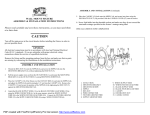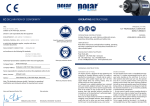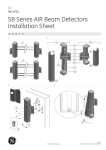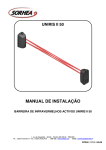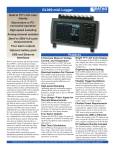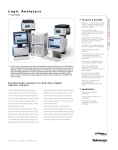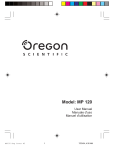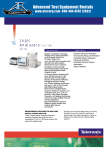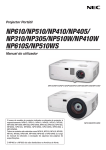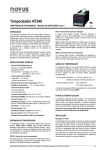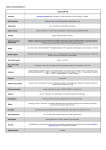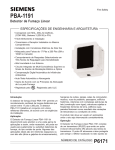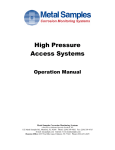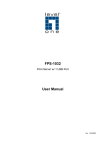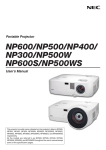Download The Ammonit Data Logger Series 32
Transcript
The Ammonit Data Logger - Series 32
Page 1 of 6
back to summary
The Ammonit Data Logger
Series 32
Overview of the data loggers - Data storage - Standards of the series 32 Software CALLaLOG02 - Technical Data - Trademarks
Before delivery to our customers, every Ammonit Data
Logger goes through a rigorous testing programme at
temperatures ranging from -30°C to +60°C. The logger
you receive has already proved it can cope with the
worst of operating conditions...
Ammonit offers reliable, userfriendly measuring
equipment for all essential climate data. The focus is primarily on
environmental protection and regenerative energy technologies. The
new Data Loggers of the "Series 32" offer much more than earlier models - including direct connections for
ultrasonic sensors.
All measuring stations are designed for long-term autonomous operation, and are able to withstand weather
influences such as extreme temperature fluctuations and high humidity. The low power consumption of the Data
Logger and the selected sensors make it possible to operate without any main power supply, using batteries or
solar panels. The wide range of accessories make it possible to provide simple system solutions, even for very
difficult locations.
All Ammonit measuring systems are enclosed in IP65 protective housings, and bear the CE-mark of the European
Commission. As an extra precaution, the Data Logger should be installed in a lockable and well earthed metal
cabinet, which not only provides better protection against weather and lightning, but also protects against theft and
vandalism. Ammonit has developed strong steel cabinets for this purpose which are also able to house additional
components. As well as providing ideal protection they ensure easy installation of the equipment on site.
The Data Loggers of the "Series 32" are flexible and can be used for a wide range of applications. The
measurement processing and data reliability meet the requirements of professional experts, but at the same time
they are so simple, that even beginners can use the Data Logger successfully. The WICOM-32, METEO-32 and
METEO-32X loggers only differ in the number of input channels they have.
In addition to storing measurements and statistics, Ammonit Data Loggers also have a
Slow Motion Recorder [SMR].
Overview of the data loggers
WICOM-32
METEO-32
METEO-32X
Anemometer
3
3
3
Wind Vanes
2
2
2
Hygrometer
1
1
Thermometer
1
1
Barometer
1
1
Pyranometer
1
1
Rain Gauge
1
1
12-bit-ADC
4
16-bit-Counter
2
Status
2
WICOM-32
The wind computer WICOM-32 is a data logger developed specially for wind energy applications. It registers the
wind speed at three heights and the wind direction at two heights - essential for the precise investigation of a
potential site and for energy predictions.
METEO-32
The METEO-32 data logger is a further development of the WICOM-32. It registers all relevant data for detailed
weather observations: Wind speed (at 3 heights), wind direction (at 2 heights), as well as temperature, relative
humidity, atmospheric pressure, solar radiation and precipitation.
METEO-32X
file://G:\instruments\3-RSW\Ammonit data logger 32 series.htm
PDF created with FinePrint pdfFactory Pro trial version http://www.pdffactory.com
2008-10-09
The Ammonit Data Logger - Series 32
Page 2 of 6
The METEO-32X data logger is developed for meteorological measurements. It registers all the relevant data
needed for detailed weather observations: Wind speeds (at 3 heights), wind direction (at 2 heights), as well as
temperature, relative humidity, atmospheric pressure, solar radiation and precipitation, and offers eight additional
free channels for other applications.
top_
Data storage
The available memory of the Data Loggers is divided into:
Measurement series memory,
Wind statistics memory and
Slow Motion Recorder [SMR]
Ring memory
All Ammonit Data Loggers have a nonvolatile 4 MB ring memory. This means:
The data sets for the measurements and wind statistics are structured in
blocks. One block in the measurement series memory, for example,
contains all the values for one day in sequence. Both individual
memories are organised as ring memories. When the memory is full, the
oldest block is then written over. This means that datasets remain in the
memory even after they have been read out, and can be accessed
again as required. Data is only deleted when space is required in the
memory for the current measurements. Successive read-outs overlap
and so the data can easily be analysed without any gaps.
Measurement series
The Data Logger produces measurement series by registering the
readings for the individual parameters at selected intervals ranging from
1 second to 1 day. If required, mean values, maxima and minima and
also standard deviations can be registered. The dataset for one day is
collected in a block, which can be read out individually. The
measurement series can transferred to a PC via a serial interface in the
form of a text file, which means that they can easily be edited and
processed using standard software (e.g. MS Excel, etc.).
Wind statistics for energy predictions
Input parameters such as wind speed and wind directions are very
dynamic. They can change in characteristic ways in the short term
("gusting"), as well as over very long periods (e.g. seasonal changes). A
series of standard methods have been developed for wind energy users
to characterise local wind regimes with only a few statistical values and
tables.
No loss of data in the event of
a power loss
Memory for 500 000
measurements
No need to bother with
deleting data to free up memory
Internal Clock
Without a precise clock, accurate
registration of date series is not
possible. But electronic clocks are
temperature-dependent. At -20°C the
deviation is already 75ppm, or 3
minutes per month.
Ammonit is not satisfied with simple
quartz timers. Using a system that we
call "gentle time control", Ammonit Data
Loggers now operate with an accuracy
of < 25ppm over the temperature range
from -30°C to +60°C.
The frequency distribution of wind speed is produced
for two anemometers with 29 classes x 1 m/s,
allowing even locations with strong winds to be
analysed fully.
The wind rose shows the distribution of the direction
of the wind in 36 sectors, allowing a detailed
investigation of energy distribution, which is
essential when planning a wind farm.
Slow Motion Recorder [SMR]
The Ammonit Data Loggers can also be used to
record wind data in detail over a specified period.
Following a programmed event, for example a wind
speed measurement that exceeds a pre-determined
threshold value, the data registered at the
measurement intervals from the wind input goes
directly to a separate memory. A total of 180
measurement lines can be recorded. This is
equivalent to a total period of 3 minutes for a 1
second measurement interval, and at lower
frequencies a correspondingly longer period will be
covered.
Graphic presentation of a measurement series (at 30m and 18m) with MS
Excel.
top
Statistics for energy predictions
The basis for the prediction of wind energy yields is the determination of
the longterm relative frequency distribution of the wind speed at the
height of the hub of the wind turbine. It can be represented by
The Rayleigh Function
If only the mean value of the wind speed is known for a location, then
this function can be used to calculate the probable variations around
this value. However, the Rayleigh distribution has a fixed form and
Statistics
provide a quick overview of relevant
wind energy data, without the need for
expensive software. Ammonit statistics
are compatible among others with
“ALWIN” evaluation software.
file://G:\instruments\3-RSW\Ammonit data logger 32 series.htm
PDF created with FinePrint pdfFactory Pro trial version http://www.pdffactory.com
2008-10-09
The Ammonit Data Logger - Series 32
can only allow for the regional variations of a site to a limited extent.
Page 3 of 6
Free download here
The Weibull function
In order to calculate the Weibull
distribution, two parameters are required:
The scaling factor A and the form parameter C.
This function describes the wind situation more
accurately than the Rayleigh Function, because
the shape of the distribution can be taken into
account.
Classification of measurement data
This method is used to bring measurement data
into a standard form reduced to the necessary
minimum.
The measured data has to be corrected in two
stages:
The chart shows an example of the frequency distribution of wind speed
Conversion to hub height
produced using "ALWIN" evaluation freeware.
Since the wind measurements are invariably
measured at heights much lower than that of the hub of the wind generator, it is necessary to convert the values to
the necessary height. To do this, the first step is to determine the roughness length at the location, where
necessary allowing for the differences in the terrain in various directions. Tables are available for the roughness
length which provide approximate guideline values on the basis of descriptions of the terrain. However, it is better
to conduct careful measurements of the wind speeds at two heights. The roughness length represents the height at
which the wind speed is slowed down to zero by the nature of terrain.
Comparisons with long-term data
Data must be recorded for at least one complete year, in order to take seasonal variations into account. This data
covering one year must then always be compared with long-term data, because the wind speed for a year can vary
by up to 20 % from the long-term mean. These comparative datasets which are needed for the corrections can
often be obtained from weather stations in the neighbourhood, from airports, or from wind generators already
installed in the area. The key is the continuity of measurements (e.g. no discontinuities due to moving the mast)
and the similarity of the topography in the locations.
Roughness length
in metres
Type of terrain
0.4
Built-up areas with trees and
numerous hedges
0.1
Farm land with some buildings and
high wind-breaks
0.03
Open ground with individual, widely
spaced obstacles
0.001
Surface waters, flat, open ground
(e.g. airport runways, mown fields,
etc.)
Definitions based on the European Wind Atlas.
The roughness length represents the height at which the wind speed is slowed down to zero by the nature of
terrain.
top
The standards of the "Series-32":
1. Recording measurement series at freely programmable intervals
2. Producing wind statistics for energy predictions
3. Slow-motion Recording (SMR) of wind data for special events
4. Three buttons and a two-line display for easy use
5. Designed for use over a temperature range from -40°C to +85°C
6. Low-Power electronics and standby-operation
7. Internal clock accurate to < 25 ppm over the entire temperature range (max. deviation approx. 1 minute / month)
8. Powered by standard 9V block battery, lithium type optional
9. Socket for external power supply 10-26 V DC
file://G:\instruments\3-RSW\Ammonit data logger 32 series.htm
PDF created with FinePrint pdfFactory Pro trial version http://www.pdffactory.com
2008-10-09
The Ammonit Data Logger - Series 32
Page 4 of 6
10. Separate power supply for wind sensors with trip switch
11. GSM-option for data transfer and e-mail / SMS
12. Remote control and data transmission through the World Wide Web
13. Internal monitor of power source and internal temperature
14. Plausibility control of measurement values
15. Generation of warnings (GSM-option)
16. 1000 KB memory (approx. 500 000 measurements)
17. Update of user software via serial interface and GSM
18. RS232-interface for data transfer (38400 baud)
19. Data compression to accelerate data transfer up to 30%
20. RS485-interface, e.g. for connecting ultrasonic anemometers
21. User friendly software for Multi-Logger-Management with graphical user interface
top
Software CALLaLOG2002
The "CALLaLOG2002" program can be used
to configure, monitor and control the data
transfer of any number of measuring stations
via modem or cable. A number of loggers can
be grouped in individual projects, each with
their own interface and a separate access
time. In this way, all the projects, with any
number of measuring systems can be
monitored quickly and efficiently.
top
Technical Data
Data Logger
Series 32
file://G:\instruments\3-RSW\Ammonit data logger 32 series.htm
PDF created with FinePrint pdfFactory Pro trial version http://www.pdffactory.com
2008-10-09
The Ammonit Data Logger - Series 32
Input channels
Page 5 of 6
P2500
WICOM-32
P2510
METEO-32
P2520
METEO-32X
3 x Wind speed
2 x Wind direction
3 x Wind speed
2 x Wind direction
1 x Rel. air humidity
1 x Air temperature
1 x Air pressure
1 x Global radiation
1 x Rain
3 x Wind speed
2 x Wind direction
1 x Rel. air humidity
1 x Air temperature
1 x Air pressure
1 x Global radiation
1 x Rain
4 x 12-bit-ADC
2 x 16-bit Counter
2 x Status
Housing
- Protection
- Dimensions
- Weight
- Connectors
IP65, connectors IP67 (closed)
120mm x 200mm x 75mm
approx. 1.2 kg (incl. batteries)
screwed miniature round-socket, Binder series 723
Power Supply
- Operation:
- External
- Current
2 alkaline batteries (9V E-Block - 6LR61 - PP3), optional lithium batteries
input 12 VDC 10...24 Volt (connector supplied)
approx.: 0,5 mA (between the measurements), 45 mA (measuring)
Temperature
- Operation
- Display readable
- 40°C ... + 85°C
- 10°C ... + 50°C
Before being delivered to the customer, each appliance must pass a 24-hour test at temperatures from -30° to
+60°C
Memory
1000 KByte non-volatile-memory (EEPROM) recorded 500.000 values.
Clock
Backup battery
Buffered real time clock, error at -30°C ... +60°C: < 25ppm
3V lithium button cells CR2032, approx. 180...230mAh
Digital output
Open-Drain, 12 ... 24VDC, approx. 20mA, e.g. can switch on or off a sensor heating via relay (also via SMS)
Data output
Display: 2 x 16 character double spaced, RS232 serial: 38.400 baud, E71 ASCII
Series measurements
- Scan interval
- Log interval
- Configuration
- Functions
1 ... 60 seconds
1 ... 9999 scan intervals
Ring memory, subdivided in daily data blocks
Average, maximum, minimum, standard deviation
Statistics
- Scan interval
- Log interval
- Configuration
- Evaluation
1 minute
Monthly according to real time calendar
Shift register, subdivided in 4 statistic blocks
29 classes ±1 m/s wind speed distribution (in 2 heights) 36 sector wind rose with unique distributions
(anemometer 1)
SMR
- Scan interval
- Memory capacity
- Configuration
1 ... 60 seconds
180 Measurement lines
separatel non-volatile memory
Included delivery
User’s manual, Batteries, Drying agent, PC-cable, 3 pin plug (ext. supply), CALLaLOG2002 Software.
Recomended sensors
- Wind speed
- Wind direction
P6100(H), P6171, P6140, P6160
(mit Adapter P9112)
P6200(H),P6230
(H),P6240,P6245
- Temperature
- Temp./ Humidity
- Air pressure
- Precipitation
top__________
P6100(H), P6171, P6140, P6160 (mit Adapter P9112)
P6200(H), P6230(H), P6240, P6245
P6471
P6831
P6520, P6542
P6720, P6721
back to summary
Copyright © 2006
Ammonit Gesellschaft für Messtechnik mbH
Wrangelstraße 100
D-10997 Berlin
file://G:\instruments\3-RSW\Ammonit data logger 32 series.htm
PDF created with FinePrint pdfFactory Pro trial version http://www.pdffactory.com
2008-10-09
The Ammonit Data Logger - Series 32
Page 6 of 6
Tel: +49 (0)30 600 31 88-0
Fax:+49 (0)30 600 31 88-10
E-mail: [email protected]
While Ammonit provides the information in this text in good faith, it in no way accepts liability for any errors or omissions, or for damages that may arise from the use of the information in
this text or from conclusions drawn from it.
Trademarks
file://G:\instruments\3-RSW\Ammonit data logger 32 series.htm
PDF created with FinePrint pdfFactory Pro trial version http://www.pdffactory.com
2008-10-09






